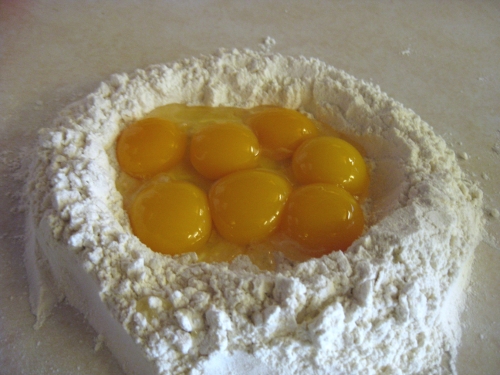
Eggs! And, eggs. Eight or nine eggs each day. It's the two-sided coin of owning 11 chickens. On one side, I'm thrilled to have fresh eggs always available. On the other, the stream of eggs is so steady at this time of the year, you can be swimming in them in no time.
My kids do all of the fetching. It's a "chore" that isn't much like one at all for them. They are getting to know the process well. They even know the sounds that come from the coop that tell them there will soon be another egg to collect. They watch, they wait. They sometimes fight over who "just got to check!!" But, they keep bringing them in, and it's my job (that I love), as the cook, to find things to make out of them.
After scrambled, fried, baked, en cocotte, hard-boiled, and poached (although I haven't completely mastered that one yet), I decided to use them in a less obviously eggy way. Yes, my children's "eggs? again?" looks factored greatly into this decision. Truthfully, even though I'm an egg lover, I've begun to feel that way too, so it was time to find something new. I decided to try Thomas Keller's 7 yolk pasta. I tried it mostly because it uses seven eggs, but also because, having Italian roots, I felt like I needed to experience making pasta by hand at least once. And, could Thomas Keller, seemingly the most fastidious person alive, put out a recipe that didn't work? Probably not.
As it's written in the French Laundry Cookbook, you make this dough entirely by hand, starting with an egg filled flour volcano(!) on your kitchen counter. Who says cooking isn't fun? You swirl and swirl the egg mixture, picking up flour gradually as you swirl, and then once it all comes together, you knead it for what seems like a lifetime, but really is about 20 minutes. I broke a sweat, my shoulders were burning, but I had a golden ball of silken dough! I wanted to set it on a shelf and sit back and admire the result of all that chicken/human labor. And I did for about 30 minutes (the time you let it rest after kneading), but then I came to my senses and remembered I was on the practical mission of dinner and got back to work.
I don't own a pasta machine, but I had read accounts of grandmothers using broom handles to roll out the dough in order to get it as thin as it needs to be, so I just went with that. There are tons of how-tos out there on rolling out and cutting pasta by hand (this is how I did the cutting). The people in the videos usually have long rollers (see a gorgeous example of one here), but know that you can use a wooden broom handle and it all comes out very well with delicious bowls of pasta and not an "eggs, again?" look to be found.
Seven Yolk Pasta adapted from The French Laundry Cookbook
*Note: this recipe uses 7 yolk, but only 1 egg white, so you will have 6 egg whites leftover. I think lightening a fritatta like this one is a great way to use them. Also, once you have all this pasta, look for ideas to use it here.
1 3/4 cups (8 ounces) all-purpose flour
6 large egg yolks
1 large egg
1 1/2 teaspoons olive oil
1 tablespoon milk
Start by mounding the flour on a clean surface, a wooden board if you have it. Make a well with an opening about 6 inches in diameter. Make sure all the walls around the opening are solid and about 1 inch wide.
Pour the egg yolks, egg, oil and the milk into the well. Break up the eggs with your fingers and once they are broken apart, start swirling the eggs around in a circular motion, making sure to keep them within the well and not spilling over. The swirling will gradually pull the flour from the sides. It's important that the flour isn't incorporated too quickly, or the dough will be lumpy. Take your time. You will need to push the sides of the well in, little by little, to maintain the gradual mixing in of flour, but still keeping the eggs inside the well. The mixture will thicken and eventually get too tight to keep turning with your fingers.
When the dough begins to thicken, use a pastry scraper (or a flat spatula) to lift the flour up and over the dough that is starting to form. Cut in the flour with the scraper. At this point, with your hands, bring the shaggy dough together and form it into a ball.
Knead the dough a few times by pressing it in a forward motion with the heels of your hands, not folding it over on itself like you would do with bread. Re-shape the dough into a ball and repeat the kneading motion several times. The dough will be moist, but not sticky. Let it rest for a few minutes while you clean your work surface.
Here is where the real kneading begins: Dust the work surface with flour. Knead the dough in the same manner as before, pushing it forward with the heels of your hands, and re-shaping it into a ball. Keep kneading in this way until the dough becomes silky smooth. The dough is ready when you can pull a finger across the top of it and it wants to snap back into place. This process will take from 15 to 20 minutes, but knead as a long as it takes to pass the pull test. If not, the dough could collapse when resting.
Double-wrap the dough in plastic wrap to ensure that it does not dry out. Let the dough rest for at least 30 minutes and up to 1 hour before rolling it through a pasta machine (or rolling out by hand). The dough can be made a day ahead, wrapped and refrigerated, but bring to room temperature before you continue.
Originally posted on Space and Thyme.
Photos by Monica Strawbridge

